This hotdog statue will change your life
The fibreglass enigma with connections to the Pope. No, really.
If you’ve been following this newsletter for a while, you might know that it has an unofficial mascot of sorts.
It’s this this grotesque statue of a hotdog man pouring tomato sauce all over his meaty, meaty body.
For many years, self-basting hotdog man has stood among the people of Bathurst on George Street.
Whenever I happen to be in town, I make a special pilgrimage to visit him. I’ve also been privileged enough to meet some of his many hotdog siblings, like this fellow who resides in Kobe.
So imagine my distress, my horror, upon arriving in Bathurst for the 12 Hour and discovering that self-basting hotdog man was missing.
Was he sold? Stolen?
No, he’s just been moved indoors. Phew.
Anyway, to honour this proud sausage, I thought I would retell his incredible story. His humble origins, unlikely connection to the pope (no really), and rise to cult hero status around the world.
Here is the legend of the self-basting hotdog man.
Freud once said: “The task of the artist is to make the human being uncomfortable”. Francis Bacon believed: “The job of the artist is always to deepen the mystery.”
Personally, I think art has served its purpose when I’m left with a lingering emotion. Joy and awe, yes absolutely. But also unease, anger or confusion. If I find myself mulling over something I’ve seen some days earlier, I know that the artist has succeeded.
Whether it be by this measure, or Freud’s, or Bacon’s, I have truly experienced something transcendent by laying eyes on this hotdog man.
No statue, painting, or novel has ever stayed with me more than this… abomination? Masterpiece? The fact I do not know speaks to its emotional enormity. Even now, the more I consider it, the more unsettled I become.
While Christ the Redeemer looks over the citizens of Rio de Janeiro, his arms warmly open, hotdog man stands among the people of Bathurst on the George Street, basting himself in sauce.
For whom is he saucing himself, I wonder?
Does hotdog man not know that condiments will only make him more delicious and, therefore, more likely to be consumed? Surely no sentient being (one capable of putting on sneakers and socks no less) would knowingly entice another creature to eat it.
Perhaps then the artist intended hotdog man as a modern religious allegory. It was Jesus, afterall, who broke bread and said: “Take and eat; this is My body.”
Will hotdog man save me from my sins?
There is a visual dichotomy at play on this statue. In one instance, the artist invites us to hunger for the hotdog man. He coyly licks his lips, as though aware of his own shameful deliciousness. On the other, the artist has purposefully added immaculately carved, individually painted fingernails to the statue.
Fingernails. On my hotdog.
It immediately makes me question how, in a practical sense, one would go about eating the hotdog man. Would you first take off his shoes and socks off and then remove his hands? Do you eat around the face? What end do you first bite into? It is too macabre to fully consider. Yet this is the mascot whose purported role is to tempt us into buying hotdogs.
I suppose you could say that the hotdog man was owned by a 1950s-style cafe in Bathurst called the Rockabilly diner. It is a larger philosophical question about whether artworks of such importance can be owned at all. Does Van Gogh’s Starry Night belong to the Museum of Modern Art? Or is it a part of the cultural inheritance of humanity?
But when searching for answers regarding Hotdog man’s provenance, back in the early part of 2024, the Rockabilly Diner was a good place to start.
I went inside that cafe on a Saturday morning, a few hours before a Supercar race, under the pretense of getting breakfast. The least offensive item on their menu was raisin toast for $6.
A women in her early 20s wearing cat-eye glasses and with hot pink hair stood behind the till. I put in my order and then started my inquiries.
“I have to ask. What’s the deal with the hotdog man?”
“I dunno,” she said.
There was a long pause. I stared unblinkingly, waiting for her to continue.
“He’s just out there I guess,” she finally finished, shrugging.
I nodded. Indeed he is.
“Do you know where the owners got it from?”
“No.”
“It has fingernails.” I whispered leaning forward.
“Yeah.”
Her tone was no different to if I’d commented on the sky being blue or the grass being green. Of course it has fingernails. It’s the hotdog man.
There was no more information to be garnered here. A few moments later I got my burnt toast in a brown paper bag along with two individually wrapped butters and a wooden knife. A sign, yellowing from age, said the business is for sale. Even hotdog man could not save them.
The Rockabilly Diner was a dead end. But thankfully, the internet provided more information.
I discovered that there isn’t just one hotdog man. Not by a long shot. There are dozens, maybe hundreds, of identical statues scattered all around the world, causing varying levels of distress.
One Sacramento radio station asks why there’s a ‘A Self-Cannibalising Hot Dog Statue’ on the roof of a local building, another article talks about the hotdog man statue ‘frightening Iowans’. Each statue has gained a certain level of local celebrity, so much so that when one ‘big wein’ was stolen in West Virginia, locals raised over $1,500 as a reward for its return.
You’d be forgiven for guessing these statues are American-made. It’s a hotdog wrapped in an American flag, after all. But, surprise surprise, it seems like the Poles could be to blame, specifically Malpol Fiberglass.
This is where things get weird. Well. Where they get weirder.
This Polish company is responsible for all manner of disquieting statues. Like this seemingly drunken chip packet who is eating itself while giving the thumbs up.
Malpol also do dinosaurs, animals, bugs and other bits of kitsch you’d see at a theme park or on the side of a highway. All tasteful stuff.
But what if, say, you were in the market for a tremendously-huge religious statue to monster a local town?
Don’t worry. They have you covered there, too.
The greatest feat of Malpol’s distinguished history was creating an enormous five-tonne, four-story tall fiberglass figure of Pope John Paul in 2013.
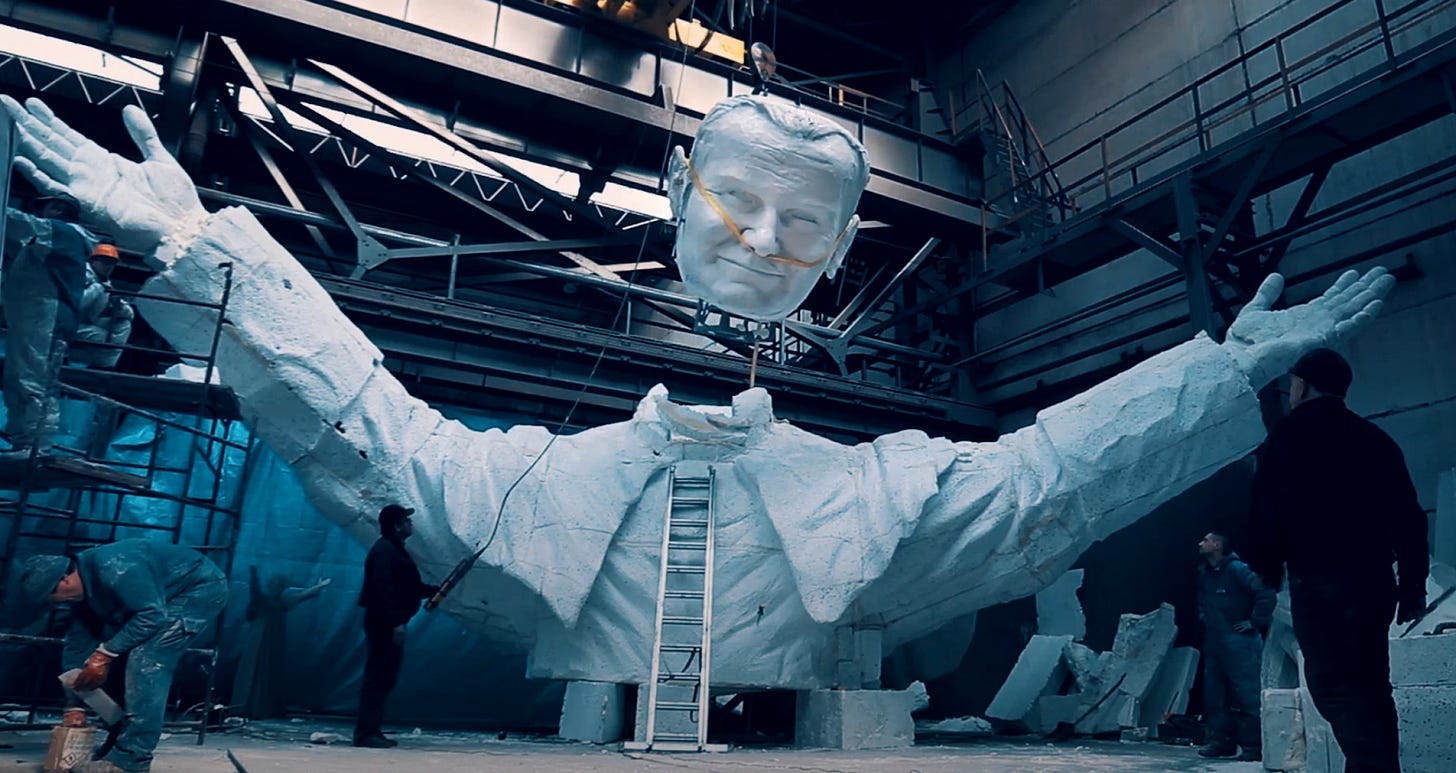
This tremendous figure, made with fiberglass supported by a metal frame, was installed on a hill just outside the town of Czestochowa. It’s the biggest Pope John Paul statue in the world. No one’s fighting for the record.
If I’d asked you yesterday what the world’s biggest pope statue and a Bathurst hotdog statue suggestively licking its lips had in common, you probably would have thought I was having a stroke. But now you have the answer: they were both made by the same company in Poland.
And so, we arrive at the end of our journey, only to find that it has raised more questions than it has answered. The self-basting hotdog man is not alone — he is part of a grand, unsettling lineage of fiberglass oddities scattered across the globe. Why and to what end? It is impossible to know.
But if ever there was proof that not every worthy work of art sits in a gallery, it is the hotdog man and his kin.

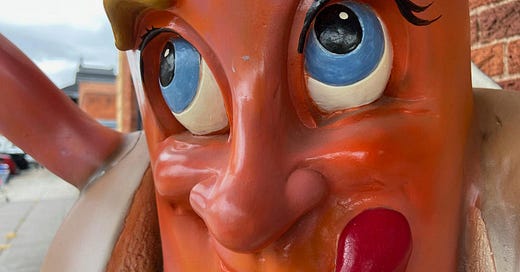


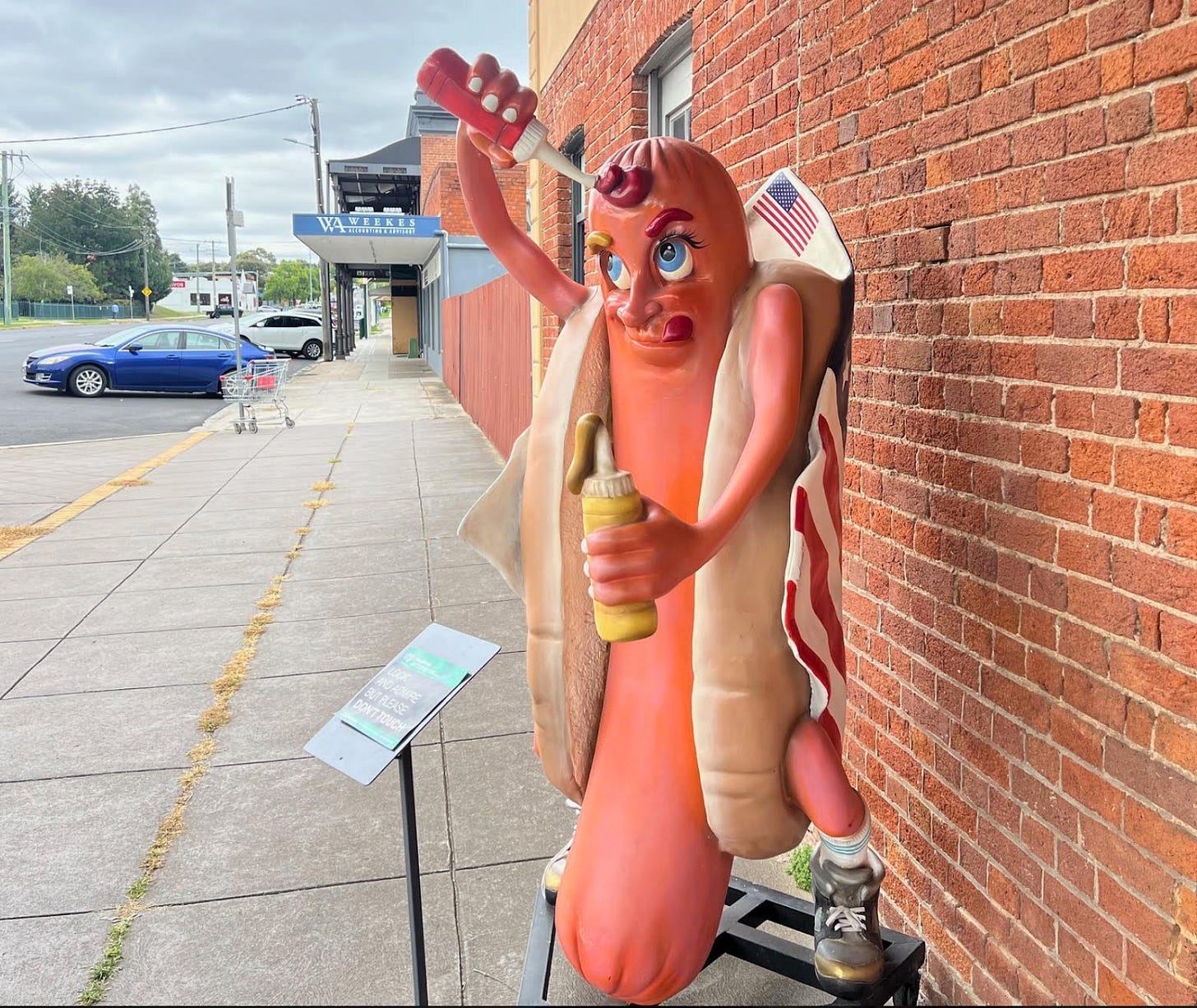
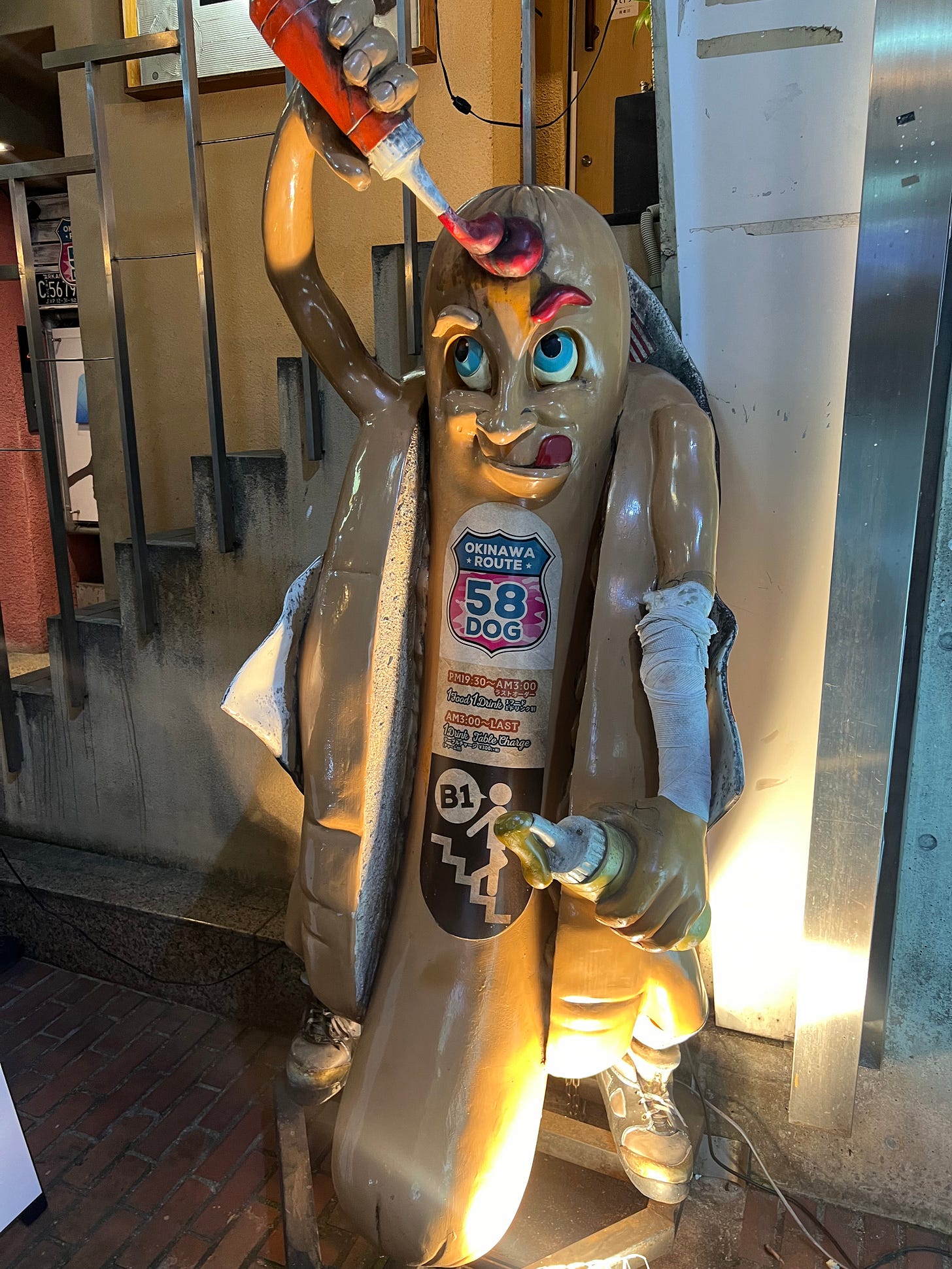
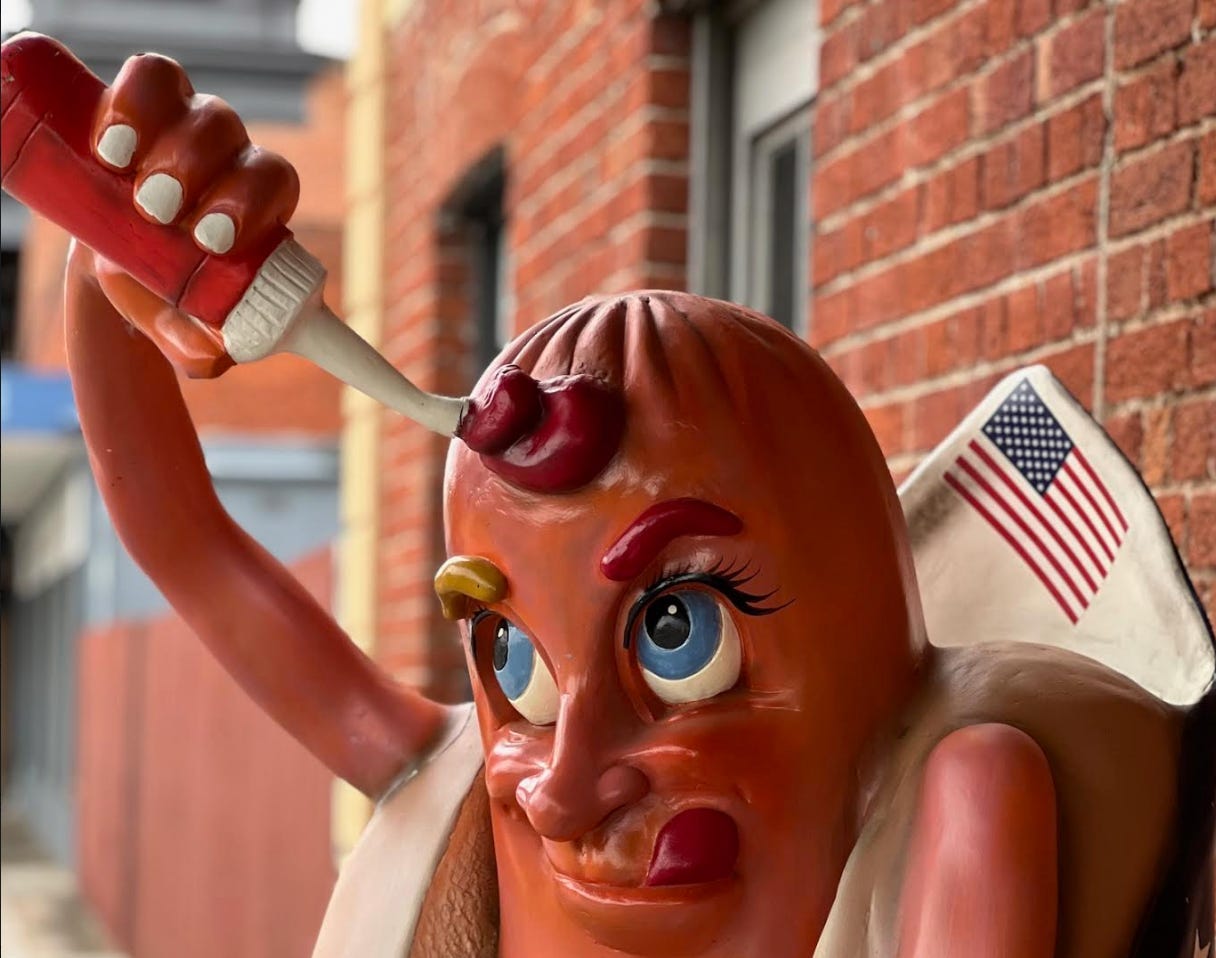


Do you think the people who make them wonder what they're doing with their lives everyday? Or do you think they're so used to it they're just like "yeah this is normal."
Fantastic read. I shouted out load “I’ve seen him!” when I saw the picture of the French fry man - but now I don’t know if I’m gaslighting myself. Or if it’s some kind of Mandala Effect thing.